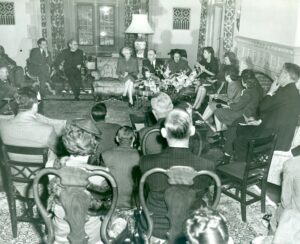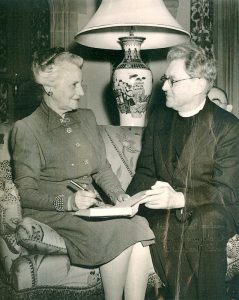 On March 21, 1947 Mrs. Marshall gladly discussed her book Together: Annal of an Army Wife with Odom Fanning of the Atlanta Journal. Mrs. Marshall stated that she wrote the book to give “a picture of General Marshall as a human being, not as a soldier or organizer.”
On March 21, 1947 Mrs. Marshall gladly discussed her book Together: Annal of an Army Wife with Odom Fanning of the Atlanta Journal. Mrs. Marshall stated that she wrote the book to give “a picture of General Marshall as a human being, not as a soldier or organizer.”
Her press conference won over her listeners with her humorous anecdotes about the man she always referred to in public as General Marshall. She refused to discuss politics but did comment on political leaders, calling Madame Chiang Kai Shek the “most extraordinary woman I have ever met.” She also revealed that she taught the Generalissimo how to play Chinese checkers during her stay in China.
While the world’s eyes were focused on Marshall as Secretary of State, Mrs. Marshall thought of him as a “man who loves fishing, hunting, riding, tennis – and especially gardening.”
The book started from a request from General Marshall for Mrs. Marshall to assemble and classify clippings, memoranda and souvenirs she had accumulated during the war years. Mrs. Marshall stated that she thought “he wanted to keep me from being lonely” while he was in China.
 The general stated publicly that he would write no memoirs. He always shunned personal publicity even though he took every opportunity to state forcefully the case for policies he believed essential to American security. So Mrs. Marshall wrote things down that might be interesting to his family and historians.
The general stated publicly that he would write no memoirs. He always shunned personal publicity even though he took every opportunity to state forcefully the case for policies he believed essential to American security. So Mrs. Marshall wrote things down that might be interesting to his family and historians.
She wrote from 2 a.m. till noon each day and finished her manuscript in a few months but she never mentioned to General Marshall that she was doing anything but putting clippings in a scrapbook. With some trepidation she finally showed the finished manuscript to him, asked him to scan the stack of papers and then left the house. He continued to read it throughout the day and in the evening Mrs. Marshall asked for his opinion. “It’s all right,” he said. “Are the facts correct?” she asked. “There are a few slight errors in dates and such, but they can be corrected easily.”
Then Mrs. Marshall asked if he had any objections to her publishing it. He was silent and then said, “I believe in free speech and a free press. If that’s the way you feel about it, go ahead and publish it.”
The book was published in 1946 and again in 1947.
